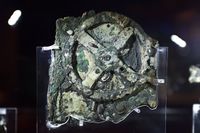Antikythera Mechanism: Difference between revisions
mNo edit summary |
mNo edit summary |
||
| Line 1: | Line 1: | ||
The Antikythera Mechanism | The Antikythera Mechanism is a mechanical device of ancient Greek origin that has been used by pseudoarchaeologists as "proof" of their beliefs about ancient aliens. | ||
[[File:Antikythera2.jpg|200px|thumb|left|Piece of the Antikythera Mechanism on display at the Archaeological Museum in Athens.]] | [[File:Antikythera2.jpg|200px|thumb|left|Piece of the Antikythera Mechanism on display at the Archaeological Museum in Athens.]] | ||
==Discovery== | |||
In the year 1900, sponge divers discovered an ancient shipwreck off the coast of Antikythera, a small Greek island in the Aegean Sea. Subsequently, the wreck was partially salvaged by the sponge divers under the supervision of Antonios Oikonomos, professor of archaeology at the University of Athens. However, factors including adverse weather conditions and the divers’ lack of training prevented the operation from being conducted in an “archaeologically scientific” manner. The ship is now believed to have been a merchant vessel that sank around 60 BC on its way to the western Mediterranean. The artifacts recovered from the wreck included bronze statues, some from the 3rd and 4th centuries BC; the most notable is the “Ephebe of Antikythera.” There were also marble statues, amphorae, ceramics, glassware, and coins. Though it is by far the most famous of the artifacts today, at the time little attention was paid to what would come to be known as the Antikythera Mechanism. | |||
==Pseudoarchaeological Claims== | |||
Ancient alien theorists have cited the Antikythera Mechanism as an example of an artifact they believe is too advanced for ancient humans to have built without help from extraterrestrials. In Chariots of the Gods, Erich von Daniken includes the Mechanism in a long list of artifacts that he believes archaeologists cannot explain. The Mechanism is also featured in season 3, episode 8 of Ancient Aliens, “Mysterious Devices,” which also posits that the Great Pyramid of Giza was actually an ancient power plant. Author and self-described “rogue archaeologist” David Childress (who has no real archaeological credentials) says that the Antikythera Mechanism is so unbelievably advanced that its discovery was like “finding a jet engine in the tomb of King Tut.” Alien hunter Jason Martell claims that “it had more complicated inner workings than a modern-day Swiss watch” and that no one knows “who could have created it and what it was used for.” | |||
Revision as of 19:22, 13 November 2019
The Antikythera Mechanism is a mechanical device of ancient Greek origin that has been used by pseudoarchaeologists as "proof" of their beliefs about ancient aliens.

Discovery
In the year 1900, sponge divers discovered an ancient shipwreck off the coast of Antikythera, a small Greek island in the Aegean Sea. Subsequently, the wreck was partially salvaged by the sponge divers under the supervision of Antonios Oikonomos, professor of archaeology at the University of Athens. However, factors including adverse weather conditions and the divers’ lack of training prevented the operation from being conducted in an “archaeologically scientific” manner. The ship is now believed to have been a merchant vessel that sank around 60 BC on its way to the western Mediterranean. The artifacts recovered from the wreck included bronze statues, some from the 3rd and 4th centuries BC; the most notable is the “Ephebe of Antikythera.” There were also marble statues, amphorae, ceramics, glassware, and coins. Though it is by far the most famous of the artifacts today, at the time little attention was paid to what would come to be known as the Antikythera Mechanism.
Pseudoarchaeological Claims
Ancient alien theorists have cited the Antikythera Mechanism as an example of an artifact they believe is too advanced for ancient humans to have built without help from extraterrestrials. In Chariots of the Gods, Erich von Daniken includes the Mechanism in a long list of artifacts that he believes archaeologists cannot explain. The Mechanism is also featured in season 3, episode 8 of Ancient Aliens, “Mysterious Devices,” which also posits that the Great Pyramid of Giza was actually an ancient power plant. Author and self-described “rogue archaeologist” David Childress (who has no real archaeological credentials) says that the Antikythera Mechanism is so unbelievably advanced that its discovery was like “finding a jet engine in the tomb of King Tut.” Alien hunter Jason Martell claims that “it had more complicated inner workings than a modern-day Swiss watch” and that no one knows “who could have created it and what it was used for.”